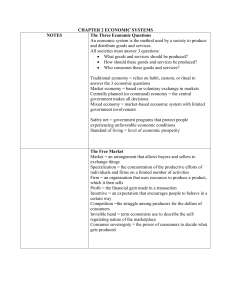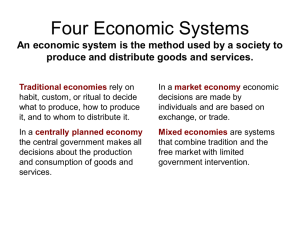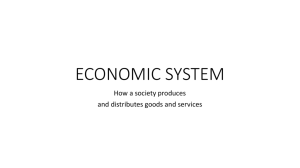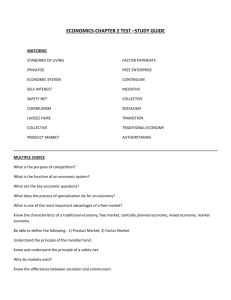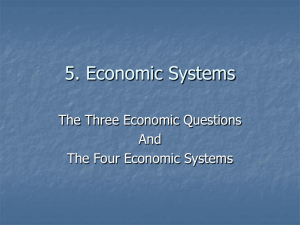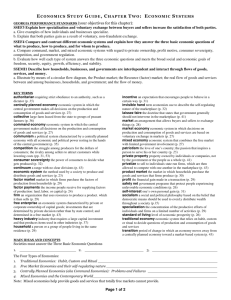File - 10-0
advertisement
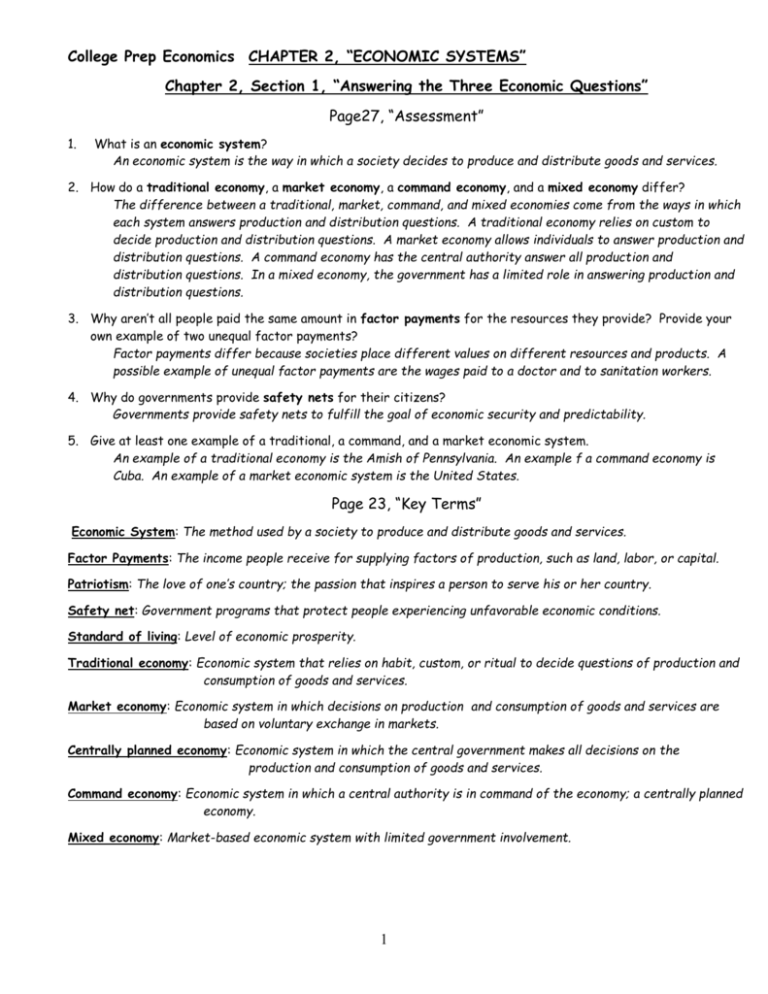
College Prep Economics CHAPTER 2, “ECONOMIC SYSTEMS” Chapter 2, Section 1, “Answering the Three Economic Questions” Page27, “Assessment” 1. What is an economic system? An economic system is the way in which a society decides to produce and distribute goods and services. 2. How do a traditional economy, a market economy, a command economy, and a mixed economy differ? The difference between a traditional, market, command, and mixed economies come from the ways in which each system answers production and distribution questions. A traditional economy relies on custom to decide production and distribution questions. A market economy allows individuals to answer production and distribution questions. A command economy has the central authority answer all production and distribution questions. In a mixed economy, the government has a limited role in answering production and distribution questions. 3. Why aren’t all people paid the same amount in factor payments for the resources they provide? Provide your own example of two unequal factor payments? Factor payments differ because societies place different values on different resources and products. A possible example of unequal factor payments are the wages paid to a doctor and to sanitation workers. 4. Why do governments provide safety nets for their citizens? Governments provide safety nets to fulfill the goal of economic security and predictability. 5. Give at least one example of a traditional, a command, and a market economic system. An example of a traditional economy is the Amish of Pennsylvania. An example f a command economy is Cuba. An example of a market economic system is the United States. Page 23, “Key Terms” Economic System: The method used by a society to produce and distribute goods and services. Factor Payments: The income people receive for supplying factors of production, such as land, labor, or capital. Patriotism: The love of one’s country; the passion that inspires a person to serve his or her country. Safety net: Government programs that protect people experiencing unfavorable economic conditions. Standard of living: Level of economic prosperity. Traditional economy: Economic system that relies on habit, custom, or ritual to decide questions of production and consumption of goods and services. Market economy: Economic system in which decisions on production and consumption of goods and services are based on voluntary exchange in markets. Centrally planned economy: Economic system in which the central government makes all decisions on the production and consumption of goods and services. Command economy: Economic system in which a central authority is in command of the economy; a centrally planned economy. Mixed economy: Market-based economic system with limited government involvement. 1 College Prep Economics CHAPTER 2, “ECONOMIC SYSTEMS” Chapter 2, Section 2, “The Free Market” Page 32, “Assessment” 1. How does specialization make us more efficient? Specialization allows each of us to focus on individual tasks and not worry about all of our basic needs at once, thus making us more efficient. 2. What is the difference between the factor market and the product market? The factor market provides goods and services that are necessary to produce more goods and services. The product market provides finished goods to consumers. 3. What is profit? Profit is the financial gain made in a transaction. 4. What are the roles of households and firms in a market economy? Households provide the factors of production in factor markets and the buying power in the product market. Firms are the buyers of factors of production and the suppliers of goods and services. 5. How does competition among firms benefit consumers? Competition benefits consumers by causing firms to sell higher-quality goods at lower prices. 6. Explain what Adam Smith meant by “the invisible hand of the marketplace.” According to Adam Smith, the “invisible hand of the marketplace” was the combination of the consumers’ self-interest and competition among firms would naturally lead to an economy in which consumers can buy the products they want at reasonable prices. 7. What is the connection between incentives and consumer sovereignty in a free market economy? Consumer sovereignty has to do with the power that consumers have to choose what they will buy, so that they exert control over what is produced by creating the incentive for firms to produce high-quality goods and services. Page 28, “Key Terms” Market: An arrangement that allows buyers and sellers to exchange things. Specialization: The concentration of the productive efforts of individuals and firms on a limited number of activities. Household: A person or group of people living in the same residence. Firm: An organization that uses resources to produce a product which it then sells. Factor market: Market in which firms purchase the factors of production from households. Profit: The financial gain made in a transaction. Product market: The market in which households purchase the goods and services that firms produce. Self-interest: One’s own personal gain. Incentive: An expectation that encourages people to behave in a certain way. Competition: The struggle among producers for the dollars of consumers. Invisible hand: Term economists use to describe the self-regulating nature of the marketplace. Consumer sovereignty: The power of the consumers to decide what gets produced. 2 College Prep Economics CHAPTER 2, “ECONOMIC SYSTEMS” Chapter 2, Section 3, “Centrally Planned Economies” Page 38, “Assessment” 1. How do socialism and communism differ? In socialist countries the government often owns major industries. Socialism has been achieved peacefully through the democratic process. In communist nations all economic and political power rests in the hands of the central government. Communist governments are authoritarian. 2. What characterizes an authoritarian government? Authoritarian governments are strongly centralized and demand strict obedience from their citizens. They do not allow individual freedom of judgment or action. 3. Why did Soviet collectives offer little incentive to farmers? Soviet collectives offered little incentive to farmers because the government paid the farmers a set wage and told them what to produce, thus providing little incentive to produce more or to produce goods more efficiently. 4. In the Soviet Union, what was the opportunity cost of the emphasis on heavy industry? The emphasis on heavy industry in the Soviet Union cost the nation adequate consumer goods and services. Page 34, “Key Terms” Socialism: A social and political philosophy based on the belief that democratic means should be used to evenly distribute wealth throughout a society. Communism: A political system characterized by a centrally planned economy with all economic and political power resting in the hands of the central government. Authoritarian: Requiring strict obedience to an authority, such as a dictator. Collective: Large farm leased from the state to group of peasant farmers. Heavy industry: Industry that requires a large capital investment and that produces items used in other industries. 3 College Prep Economics CHAPTER 2, “ECONOMIC SYSTEMS” Chapter 2, Section 4, “Modern Economies” Page 44, “Assessment” 1. What is laissez faire? Laissez faire is the doctrine that states that government should not intervene in the marketplace. 2. Why have some nations begun a transition to free enterprise? Some centrally planned nations are switching to a free enterprise system in order to keep pace with the evolving global economy. 3. Why are nations with centrally planned economies sometimes slow to succeed when they privatize industry? Privatization is usually a slow process in centrally planned economies because, typically, few enterprises or businesses exist when privatization begins. 4. Compare the U.S. free enterprise system with other economic systems you have read about in this chapter. The U.S. free enterprise system offers a great deal of freedom for the consumer as well as firms. In addition, individuals, not the government, make most economic decisions. Page 40, “Key Terms” Laissez faire: The doctrine that states that government generally should not intervene in the marketplace. Private property: Property owned by individuals or companies, not by the government or the people as a whole. Free enterprise: An economic system characterized by private or corporate ownership of capital goods; investments that are determined by private decision rather than by state control; and determined in a free market. Continuum: A range with no clear divisions. Transition: Period of change in which an economy moves away from a centrally planned economy toward a marketbased system. Privatize: To sell state-run firms to individuals. 4

